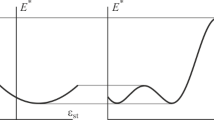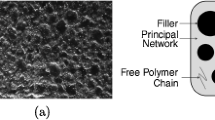Abstract
Determination of mechanical characteristics of filled polymer materials in shock wave processes is of interest in calculations of the strength of these materials. The standard computation methods are based on the use of the linear theory of viscoelasticity, where there is no distinction between the active and passive deformation processes. In the present paper, dynamical experiment and theoretical modeling are used to illustrate the important role played by the sharp decrease in the resistance of a filled polymer material in unloading (in the millisecond time range). The higher the degree of filling of this material, the more significant this effect is.
Similar content being viewed by others
References
D. L. Bykov, D. N. Konovalov, V. P. Mel’nikov, and A. N. Osavchuk, “Method for Identification of the Filled Polymer Material Relaxation Kernel in Millisecond Time Range,” Izv. Akad. Nauk. Mekh. Tverd. Tela, No. 3, 143–154 (2010) [Mech. Solids (Engl. Transl.) 45 (3), 427–436 (2010)].
J. J. Grefenstette, “Optimization of Control Parameters for Genetic Algorithms,” IEEE Trans. Syst. Man Cybernetics 16(1), 122–128 (1986).
D. L. Bykov and V. A. Peleshko, “Constitutive Relations for Strain and Failure of Filled Polymer Materials in Dominant Axial Tension Processes under Various Barothermal Conditions,” Izv. Akad. Nauk. Mekh. Tverd. Tela, No. 6, 40–65 (2008) [Mech. Solids (Engl. Transl.) 43 (6), 870–891 (2008)].
S.W. Park and R. A. Schapery, “A Viscoelastic Constitutive Model for Particulate Composites with Growing Damage,” Int. J. Solids Struct. 34(8), 931–947 (1997).
Ş. Özüpek, Constitutive Equations for Solid Propellants, PhD Dissertation (Univ. Austin, Texas, 1997).
G. D. Jung and S. K. Youn, “A Nonlinear Viscoelastic Constitutive Model of Solid Propellant,” Int. J. Solids Struct. 36(25), 3755–3777 (1999).
D. L. Bykov, D. N. Konovalov, and V. A. Peleshko, “Constitutive Relations for Calculating the Processes of Quasistatic Deformation, Damage, and Fracture of Bodies (Including Those with Concentrators) Made of Filled Polymer Materials,” Izv. Akad. Nauk. Mekh. Tverd. Tela, No. 6, 34–54 (2011) [Mech. Solids (Engl. Transl.) 46 (6), 839–855 (2011)].
D. L. Bykov and V. A. Peleshko, “Constitutive Relations of Strain, Anisotropic Degradation, and Fracture of Filled Polymer Materials in Prevailing-Tension Processes with Varying Axis Direction and Relaxations,” Izv. Akad. Nauk. Mekh. Tverd. Tela, No. 5, 59–67 (2009) [Mech. Solids (Engl. Transl.) 44 (5), 705–711 (2009)].
Author information
Authors and Affiliations
Corresponding author
Additional information
Original Russian Text © D.L. Bykov, A.V. Kazakov, D.N. Konovalov, V.P. Mel’nikov, A.N. Osavchuk, V.A. Peleshko, 2012, published in Izvestiya Akademii Nauk. Mekhanika Tverdogo Tela, 2012, No. 6, pp. 52–57.
About this article
Cite this article
Bykov, D.L., Kazakov, A.V., Konovalov, D.N. et al. Identification of the model of nonlinear viscoelasticity of filled polymer materials in millisecond time range. Mech. Solids 47, 641–645 (2012). https://doi.org/10.3103/S0025654412060052
Received:
Published:
Issue Date:
DOI: https://doi.org/10.3103/S0025654412060052




